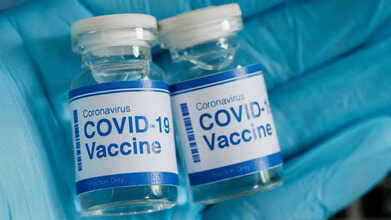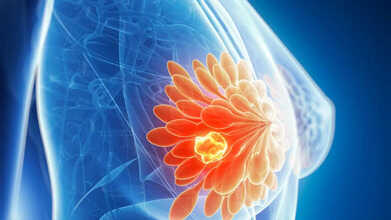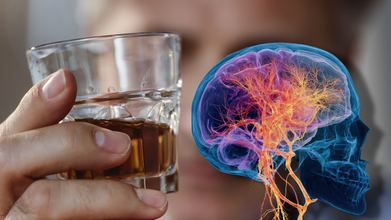- Health Conditions A-Z
- Health & Wellness
- Nutrition
- Fitness
- Health News
- Ayurveda
- Videos
- Medicine A-Z
- Parenting
- Web Stories
Who Is Eligible For The COVID Vaccine Or Autumn Booster In The UK?

Credits: Canva
Who is eligible for covid shot 2025: This year, there has been a “significant change” in who can get the COVID vaccine, according to Community Pharmacy England (CPE). The updated eligibility rules have caused confusion among the public and, in some cases, led to abusive behaviour towards pharmacy staff. Pharmacy teams report that up to half of the patients booked through the NHS National Booking Service (NBS) aren’t eligible, while some ineligible individuals have been sent by their GPs. The National Pharmacy Association (NPA) describes the situation as “deeply frustrating” for both patients and pharmacists.
Who Is Eligible for the COVID Vaccine In the UK This Winter?
This winter, the NHS is offering the COVID vaccine to:
- People aged 75 and over
- Anyone aged six months to 74 with a weakened immune system
- Residents of care homes for older adults
Getting vaccinated this autumn helps protect against serious illness from COVID over the winter months.
How to Book the Vaccine?
Eligible individuals are encouraged to book via the NHS online booking service or the NHS app. People aged five and over who are eligible can also walk into a vaccination site without an appointment. Those who don’t meet the criteria can still get the vaccine privately.Flu Jab Eligibility
More people qualify for the flu jab, including:
- Those over 65
- People with long-term health conditions
- Pregnant women
- All primary school children
- Secondary school children in years 7–11
- Frontline healthcare workers
- Care home residents
- Certain carers or people living with someone with a weakened immune system
Why Are Some Booking Errors Happening?
Confusion has arisen because the online system allows patients to book COVID and flu vaccines at the same time. Henry Gregg, chief executive of the NPA, said:
“This situation should have been avoidable and is very frustrating for both pharmacies and patients. We ask that patients treat pharmacy staff with respect as they navigate the new NHS rules. We’ve raised the issue with NHS England and the Department of Health and hope for a quick resolution.”
What Is the Autumn Booster?
By autumn, protection from earlier COVID vaccines can start to wane. For those at higher risk of severe illness, the NHS provides a free autumn booster.
The current vaccines continue to provide strong protection against hospitalisation and serious disease. Data from UKHSA shows that people who received a booster last autumn were around 43% less likely to be admitted to hospital with COVID-19, starting two weeks after vaccination, compared to those who remained unvaccinated.
Can A Fall Lead To Dementia? Major Study Finds That Head Injuries May Increase Risk By 69% And Calls For Urgent Prevention Measures

(Credit-Canva)
A seemingly simple fall can have far-reaching consequences, especially for older adults. New research from Canada tracking 260,000 seniors for 17 years (April 2004-March 2020) reveal a striking link between traumatic brain injuries (TBI) and a heightened risk of developing dementia, shedding light on how a single accident could accelerate cognitive decline.
Can Head Injuries Lead To Dementia?
The study found that older adults who suffered a TBI from any cause had a 69 percent higher risk of being diagnosed with dementia within the next five years compared to those who did not have a TBI. Even after five years, TBI sufferers still had a 56 percent higher risk of a dementia diagnosis.
While the study didn't look at falls specifically, falls are the most common reason for TBIs in older adults, causing an estimated 80 percent of cases.
Researchers emphasized that these falls are in fact preventable. They explained that by targeting fall-related TBIs, there is a huge potential that they can reduce TBI-associated dementia."
Why Do Head Injuries Cause Dementia?
The study authors did not give a specific reason for the link, but previous research suggests two main possibilities.
Direct damage: this suggests that the head injury itself—like bruising or bleeding in the brain can hurt brain cells. This damage might then cause abnormal proteins, which are strongly linked to dementia, to build up faster.
Pre-Existing Conditions: It is also possible that patients who suffer a fall or TBI already have undiagnosed dementia or Mild Cognitive Impairment (MCI). These conditions are known to make falls more likely, and the head trauma may then speed up the disease's progression.
Who Is More At Risk For Dementia Due To Injury?
The research revealed that the risk of dementia after a TBI is not the same for everyone:
Age and Gender
Women aged 75 years or older were found to be the most at risk of developing dementia after suffering a TBI. This may be because women tend to live longer and are more likely to suffer from conditions like muscle weakness or bone thinning (osteoporosis), which increase the risk of falls.
Overall Risk
Among people aged 85 years or older who suffered a TBI, about one in three eventually developed dementia.
Community
Patients who were older and lived in smaller communities and areas with low income and less ethnic diversity were the most likely to be admitted to a nursing home after a TBI.
Why Should We Pay More Attention To TBI?
According to the International Brain Injury Association, injuries to the brain are some of the most dangerous kinds of injuries a person can suffer. They are among the most likely to cause death or permanent disability.
In fact, brain injury is the leading cause of death and disability worldwide. It is also the main cause of long-term seizure disorders. Because of how serious these injuries are, the World Health Organization (WHO) started tracking them officially in 1993. Traumatic Brain Injury (TBI) is a major health issue in the United States every year. Today, an estimated 5.3 million Americans are living with disabilities caused by a TBI.
They emphasize that brain injury is a public health concern that requires continued research to find better medical treatments, as well as increased efforts to prevent the injuries from happening in the first place.
Breast Cancer Awareness: Identifying Breast Lumps—Cyst or Tumor?

Credits: Canva
Lumps can develop in breast tissue in people of all sexes and genders. If you notice a lump, whether you suspect it might be a cyst, a tumor, or something else, it is important to consult a doctor. While most breast lumps are not cancerous, some noncancerous lumps still need treatment, and only a medical professional can confirm whether a lump is cancerous or not.
To understand the difference, we spoke with Dr. Sumol Ratna, Assistant Professor in the Department of Medicine at NIIMS Medical College & Hospital.
Breast Cysts vs. Tumors
The most common types of breast lumps are cysts and tumors, and knowing the difference can help reduce worry. Dr. Ratna explains, “A breast cyst is a fluid-filled sac that forms within the breast tissue. These are usually non-cancerous and are most often seen in women between 30 and 50, especially after menopause.”
Cysts may appear as a single lump or multiple lumps of varying sizes. Depending on the amount of fluid inside, a cyst may feel soft or firm. Hormonal changes during the menstrual cycle can sometimes make them feel larger or slightly tender. Most of the time, cysts do not cause pain, although mild discomfort may occur at the lump site. Diagnosis is usually done via ultrasound, and if a cyst is found, a fine needle aspiration can confirm it contains fluid. Once drained, the cyst typically shrinks or disappears.
A breast tumor, on the other hand, is an abnormal growth of cells in the breast. Dr Ratna said, “Tumors may be benign or malignant. Benign tumors, such as fibroadenomas, are solid, well-defined, and do not spread to other parts of the body. Malignant tumors, however, are cancerous and can invade nearby tissues or organs.” Tumors are generally hard, irregularly shaped, and fixed in place. They may sometimes cause changes like skin dimpling or fluid from the nipple, but pain is usually not present.
Types of Breast Cysts
- Simple cysts: Completely filled with fluid, always noncancerous, with thin, smooth walls.
- Complex cysts: Have thick, irregular walls and may contain some solid mass or debris. Doctors may drain fluid to test for abnormalities and rule out cancer.
- Complicated cysts: Combine features of simple and complex cysts. They usually have thin, smooth walls but may contain small amounts of debris.
How Doctors Tell the Difference
Doctors use a range of tests to determine whether a tumor is benign or malignant. Cysts are generally smooth and movable, while tumors tend to be hard and fixed. Ultrasound is commonly used for diagnosing cysts, whereas tumors usually require mammograms and biopsies.
While both cysts and tumors can appear as single lumps, their characteristics and implications are very different. Any noticeable change in the breast shape, or discharge from the nipple, should prompt a visit to a breast specialist. Early evaluation is key to peace of mind and proper treatment.
Why It’s So Hard To Quit Alcohol: Scientists Discover The Brain Circuit That Fuels Addiction And Relapse

Alcohol addiction is a disease that plagues many people throughout the world. According to the World Health Organization, 209 million people in the world live with alcohol dependence. In 2024, the National Institute on Alcohol Abuse and Alcoholism (NIAAA) recorded that 27.9 million people aged 12+ had Alcohol Use Disorder (AUD) 775,000 youth (3.0%) and 27.1 million adults (10.3%) had AUD.
Alcohol has also been attributed to 2.6 million deaths in 2019. Addiction has cost many lives, however, despite knowing how bad alcohol is for not just their health, but their relationships, people still go back to it. Why? A new study may have found the answer to that.
What makes a person keep drinking alcohol, even when it harms their health and relationships?
A new study from Scripps Research offers a major clue. It shows that people often drink not for pleasure, but to escape the stress and misery of withdrawal. A tiny area in the brain is key to this learning process.
What Part Of The Brain Is Responsible For Relapse?
In a study published on August 5, 2025, researchers focused on a group of brain cells in rats located in a small, central area called the paraventricular nucleus of the thalamus (PVT).
The researchers found that the PVT area became much more active when the rats learned that drinking alcohol would make the awful feelings of withdrawal go away.
The problem people with alcohol dependency face is that this activity in the PVT drives a powerful urge to seek alcohol, leading to strong relapse behavior.
The researchers explained that the thing that makes addiction so hard to break is in the psychology, some people are not just chasing a high. They explain that many times these people are trying to get rid of powerful negative states, like the stress and anxiety of withdrawal.
Where Does Alcohol Addiction Stem From?
Millions of people struggle with alcohol use disorder, which often involves a difficult cycle: trying to quit, dealing with painful withdrawal, and then relapsing (starting to drink again). This study helps explain why the urge to relapse is so powerful. The study showed that the brain learns a powerful lesson: alcohol stops the pain.
Rats quickly learned that drinking gave them relief from the stressful, bad feelings of withdrawal.
This learning was so strong that they would try very hard to get alcohol—they kept seeking it out even if they had to overcome difficulties or faced punishment.
In every rat that learned this pattern, a tiny area of the brain called the PVT became highly active, or "lit up." This is the circuit that links alcohol to relief from stress. The PVT is already known to handle stress and anxiety, so it makes sense that it activates to escape the stress of withdrawal.
Can You Manipulate Your Brain To Not Relapse?
The findings are important for more than just alcohol addiction. The brain's drive to act in order to escape stress or pain is common in many human behaviors. The results could help treat other conditions, including:
- Anxiety disorders.
- Intense fear or learning to avoid things after trauma.
Researchers now plan to study women and look closely at the chemicals in the PVT area. If they can find the specific molecules involved in this escape learning, it could open new doors for creating better medications that target the brain's mechanism for avoiding pain, offering a new way to help people recover.
© 2024 Bennett, Coleman & Company Limited

